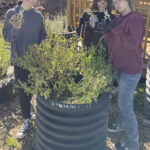Debbie Kober: Using Brix in the garden
When you think of bricks in the garden, you may think of walking paths, edging or retaining walls but many people are not familiar with the use of Brix in their gardens.
They sound the same but that’s where the similarities end.
Brix is a measure of the amount of sugars in plant materials. More specifically, a Brix value is the amount of dissolved sugar in a solution. Each degree Brix is equal to 1 gram of sucrose in 100 grams of solution.
By taking a small amount of plant material (leaf, stem, flower, root or fruit), crushing it to extract a few drops of liquid, and placing it on a simple refractometer, which can be found for around $20, you can get a percent sugar reading (a reading of 10 equals 10 percent sugars).
But, what do you do with that information?
For many years, commercial fruit and vegetable growers have taken samples from the fruit or vegetable itself and used the Brix reading to determine readiness for harvest. This can also be useful in your home orchard or garden as well.
More recently, research from Thomas Dykstra, PhD, has found interesting correlations between the Brix reading in leaf material to overall plant health and susceptibility to pest and disease. A healthier plant produces more sugars through photosynthesis which results in a higher Brix reading.
He also noticed different pest types attacked plants at very specific Brix levels and at some point, usually above 12, pests lose interest in the plant altogether. From this he created guidance helpful to the home gardener showing what type of pest will attack a plant.
Below is the list of Brix levels where the type of pest listed loses interest and moves on: 6-8 — Aphids and scale 7–9 — Sucking insects (leafhoppers, stink bugs, thrips, etc.)
9-11 — Chewing insects (caterpillars, beetles, butterflies, moths, etc.)
10-12 — Grasshoppers, crickets, etc.
Above 12, very little pest pressure is found on plants.
If you find your garden is affected by one of these pests, Brix levels may be increased and can quickly address the issue. Since a low Brix reading could be from any number of deficiencies, it is important to identify the exact cause and treat accordingly.
This is commonly from the use of nitrate nitrogen fertilizers, low calcium, phosphorous or boron levels. Once the deficiency is identified and provided, plants will respond quickly. Researchers have found increases in Brix levels in as little as one hour after application of the needed nutrient, and as soon as it reaches the upper limit for that type of pest, they will move on.
If you’d like to learn more about Brix and how to identify and treat deficiencies in your home orchard or garden, there is a wealth of information on the internet. Look for anything from Thomas Dykstra. There is also a short, information packed video on the Dr. Elaine Productions channel on YouTube called Steps to Increase Brix and Refractometer – An Indispensable Monitoring Tool.
Debbie Kober is a member oft he Barry County Master Gardeners. More information on the gropu may be found on its Facebook page, “Master Gardeners of Barry County Missouri.







